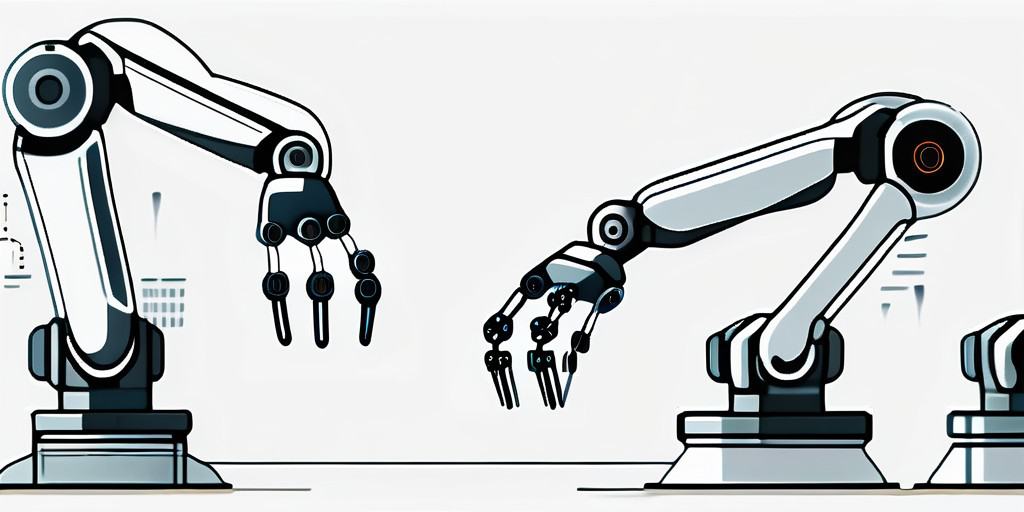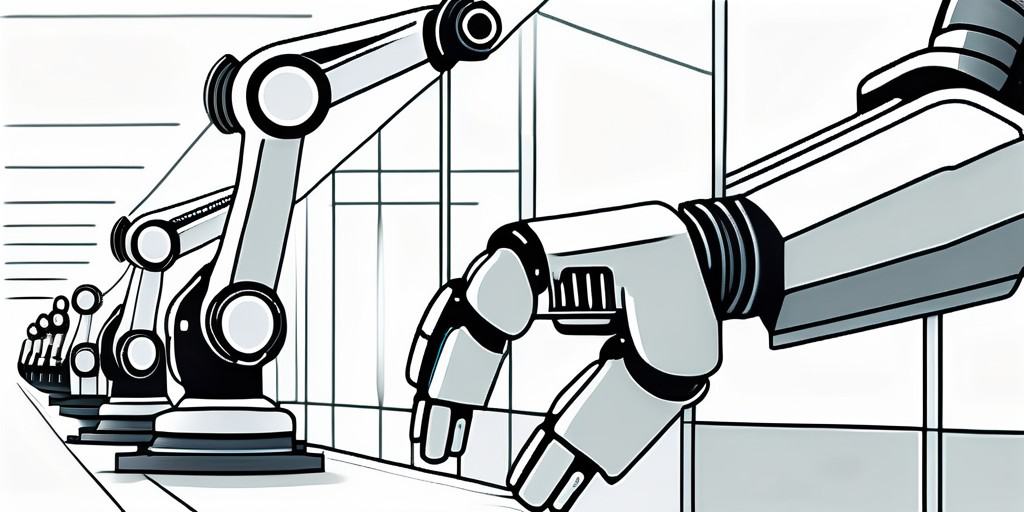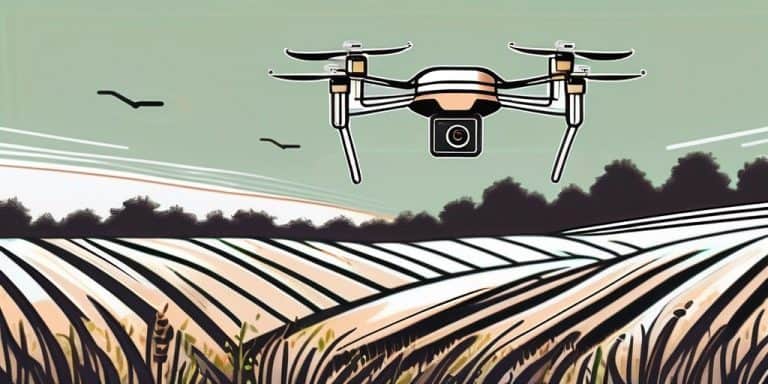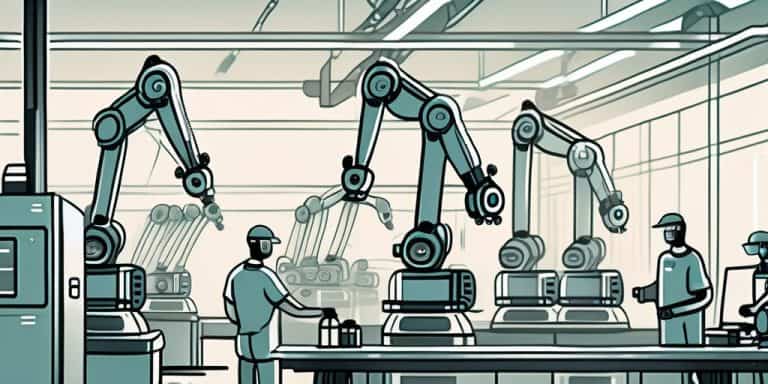
Examples of Speech Synthesis in the Legal System
Discover how speech synthesis technology is revolutionizing the legal system with real-world examples.

In recent years, speech synthesis technology has made significant strides in various industries, including manufacturing. This groundbreaking technology has revolutionized the way manufacturers communicate, automate processes, and enhance efficiency on the production floor. This article delves into the different aspects of speech synthesis in manufacturing, exploring its role, applications, future trends, and potential challenges.
Before delving into its applications, it is essential to have a basic understanding of speech synthesis. Speech synthesis, also known as text-to-speech (TTS) technology, converts written text into spoken words. It uses algorithms and linguistic rules to generate human-like speech, replicating the nuances of natural language. Through the synthesis of speech, manufacturers can communicate instructions, alerts, and other crucial information to workers in an effective and efficient manner.

Speech synthesis technology has come a long way since its inception. Initially, early attempts at speech synthesis produced robotic and unnatural-sounding voices. However, advancements in technology and research have led to significant improvements in the quality and naturalness of synthesized speech. Today, speech synthesis systems can produce voices that are almost indistinguishable from human voices, with accurate intonation, rhythm, and pronunciation.
At its core, speech synthesis involves three main components: text analysis, linguistic processing, and speech generation. Text analysis involves breaking down written text into its constituent parts, such as words, phrases, and sentences. This process includes identifying punctuation marks, capitalization, and other elements that contribute to the overall meaning and structure of the text.
Once the text is analyzed, linguistic processing comes into play. Linguistic processing involves applying rules and algorithms to convert text into a phonetic representation that can be accurately pronounced. This step is crucial to ensure that the synthesized speech sounds natural and intelligible. Linguistic processing takes into account various factors, such as the context of the text, the intended audience, and the desired style of speech.
Finally, speech generation utilizes pre-recorded or synthesized voice data to create spoken words in a clear and intelligible manner. In some cases, speech synthesis systems use recordings of human voices to generate speech. These recordings are carefully segmented and combined to form the desired words and sentences. In other cases, speech synthesis systems use advanced algorithms to generate speech from scratch, without relying on pre-recorded data.
Speech synthesis technology plays a significant role in various technological advancements. In manufacturing, it has become a crucial tool for enhancing communication, reducing errors, and increasing productivity. By converting written information into audible instructions, workers can easily comprehend and act upon the given instructions, irrespective of their literacy levels or language barriers.
Speech synthesis is not limited to manufacturing alone. It has found applications in various other fields as well. For example, in the field of assistive technology, speech synthesis enables individuals with visual impairments to access written information. By converting text into speech, these individuals can listen to books, articles, and other written materials, thereby gaining access to a wealth of knowledge.
Moreover, speech synthesis technology has also made its way into the entertainment industry. In video games and animated movies, speech synthesis is used to bring characters to life. By giving voices to virtual characters, speech synthesis adds a layer of realism and immersion to the gaming and cinematic experiences.
In conclusion, speech synthesis technology has revolutionized the way we communicate and interact with machines. With its ability to convert written text into spoken words, speech synthesis enables effective communication, enhances accessibility, and opens up new possibilities in various fields. As technology continues to advance, we can expect further improvements in speech synthesis, leading to even more realistic and natural-sounding voices.
Speech synthesis technology has intersected with manufacturing in remarkable ways, opening up new possibilities and transforming traditional processes. Its integration into manufacturing environments brings numerous benefits and improvements.

One of the key advantages of speech synthesis in manufacturing is its ability to streamline communication between humans and machines. On the factory floor, workers can receive real-time instructions, alerts, or safety notifications through speech synthesis systems, eliminating the need for manual reading or interpretation of written documents. This not only saves time but also minimizes errors and enhances overall efficiency.
Imagine a bustling manufacturing plant where workers are constantly bombarded with written instructions, safety guidelines, and updates. It can be overwhelming and time-consuming to read through all the information, especially in a fast-paced environment. However, with the integration of speech synthesis technology, workers can simply listen to the instructions as they work, allowing them to focus on the task at hand without the distraction of reading. This not only improves productivity but also reduces the risk of errors caused by misinterpretation of written instructions.
Furthermore, speech synthesis systems can be customized to deliver instructions in different languages or accents, ensuring effective communication in diverse work environments. This is particularly beneficial in manufacturing facilities that employ a multicultural workforce, as it eliminates language barriers and promotes inclusivity.
Speech synthesis technology is reshaping the manufacturing landscape by enabling greater automation and reducing dependency on manual interventions. For instance, speech synthesis systems can provide audio-guided instructions for assembly line workers, ensuring precise and efficient execution of tasks. Moreover, these systems can generate real-time feedback and alerts, signaling deviations or anomalies in the manufacturing process, allowing for immediate corrective actions.
Imagine a scenario where a manufacturing plant is producing thousands of units per hour on an assembly line. In such a fast-paced environment, it is crucial to ensure that each task is performed accurately and efficiently. With speech synthesis technology, assembly line workers can receive step-by-step instructions directly through their earpieces, guiding them through the assembly process with precision. This eliminates the need for constant supervision and reduces the risk of errors caused by human oversight.
Additionally, speech synthesis systems can continuously monitor the manufacturing process, analyzing data in real-time to detect any abnormalities or deviations. If a machine malfunctions or a process goes off track, the system can immediately alert the relevant personnel, allowing them to take prompt corrective actions. This proactive approach minimizes downtime, reduces wastage, and optimizes overall production efficiency.
Furthermore, speech synthesis technology can be integrated with other manufacturing systems, such as inventory management or quality control, creating a seamless and interconnected ecosystem. This integration enables real-time updates and notifications, ensuring that all relevant stakeholders are informed and can make informed decisions based on accurate and up-to-date information.
In conclusion, the intersection of speech synthesis and manufacturing has revolutionized the industry by enhancing communication, improving efficiency, and enabling greater automation. As technology continues to advance, we can expect further innovations in speech synthesis that will continue to transform the manufacturing landscape.
Speech synthesis has found applications across various manufacturing processes, disrupting traditional approaches and introducing new possibilities.

In assembly line environments, workers are often faced with complex instructions and changing requirements. Speech synthesis technology simplifies this process by providing clear, audible instructions, minimizing confusion and errors. By following audio-guided instructions, workers can improve their productivity and reduce the learning curve associated with manual processes.
Quality control is a critical aspect of manufacturing, ensuring that products meet the required standards. Speech synthesis technology can play a vital role in this area by providing real-time audio feedback on quality parameters. By audibly notifying workers of any defects or deviations, speech synthesis systems enable immediate actions, preventing faulty products from progressing further down the production line.
As technology continues to advance, the future of speech synthesis in the manufacturing industry looks promising.
Experts predict that speech synthesis systems will become more sophisticated, offering improved natural language processing capabilities and enhanced voice quality. These advancements will further enhance comprehension and usability, ultimately leading to increased adoption and integration within manufacturing processes.
While speech synthesis technology offers numerous benefits, it also presents certain challenges. Factors such as language compatibility, pronunciation accuracy, and integration complexity may pose obstacles during implementation. However, ongoing research and development efforts aim to address these challenges, ensuring seamless integration and maximizing the potential of speech synthesis in manufacturing.
In conclusion, the integration of speech synthesis technology in manufacturing processes has brought about significant benefits and improvements. It has revolutionized communication between humans and machines, enabling streamlined operations, improved productivity, and enhanced efficiency. While there are challenges to overcome, the future holds great potential for further advancements in speech synthesis technology, ensuring that it continues to play a vital role in the manufacturing industry.
The benefits of speech synthesis technology in manufacturing are manifold. It enables rapid and accurate communication, reduces errors, enhances productivity, and reduces the learning curve associated with manual processes. By providing real-time audio instructions and feedback, speech synthesis systems empower workers and improve the overall manufacturing experience.
Alongside its benefits, speech synthesis technology also raises ethical considerations. The use of synthesized voices, particularly in customer-facing interactions, may impact authenticity and human connection. Striking a balance and ensuring ethical guidelines are in place is essential to prevent potential drawbacks and maintain a positive user experience.



Discover how speech synthesis technology is revolutionizing the legal system with real-world examples.

Explore how speech synthesis technology is revolutionizing the agricultural industry with real-world examples and applications.

Explore how speech synthesis technology is revolutionizing customer service with real-life examples.
